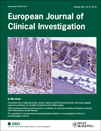Sensitive troponin and N-terminal probrain natriuretic peptide in stable angina
Abstract
Eur J Clin Invest 2011; 41 (10): 1054–1062
Background High-sensitivity cardiac troponin (hs-TnT) and N-terminal probrain natriuretic peptide (NT-proBNP) are powerful predictors of mortality in patients with stable coronary artery disease. Whether their combined use may further improve mortality prediction in these patients is unknown.
Materials and methods The study included 869 patients with stable coronary artery disease who underwent percutaneous coronary intervention. Hs-TnT and NT-proBNP were measured before angiography. Using median values of hs-TnT (0·008 μg L−1) and NT-proBNP (250·0 ng L−1) as cut-off points, patients were divided into four groups: low hs-TnT/low NT-proBNP group (293 patients with hs-TnT and NT-proBNP < median); low hs-TnT/high NT-proBNP group (142 patients with hs-TnT < median and NT-proBNP ≥ median); high hs-TnT/low NT-proBNP group (142 patients with hs-TnT ≥ median and NT-proBNP < median) and high hs-TnT/high NT-proBNP group (292 patients with hs-TnT and NT-proBNP ≥ median). The primary end point was all-cause mortality.
Results The 4-year follow-up was complete in 90·7% of the patients. There were 76 deaths during the follow-up: seven in low hs-TnT/low NT-proBNP, 8 in low hs-TnT/high NT-proBNP, 10 in high hs-TnT/low NT-proBNP and 51 in high hs-TnT/high NT-proBNP groups (mortality estimates, 2·5%, 5·9%, 7·4% and 18·1%, respectively; odds ratio = 8·64, 95% confidence interval 3·85–19·4, P < 0·001 for high hs-TnT/high NT-proBNP vs. low hs-TnT/low NT-proBNP). Inclusion of hs-TnT and NT-proBNP in the multivariable model increased the discriminatory power of the model regarding mortality prediction compared with the model without biomarkers (absolute and relative integrated discrimination improvement 0·039 and 26·0%, P = 0·0015).
Conclusions Combined use of hs-TnT and NT-proBNP improves long-term risk prediction of mortality in patients with stable coronary heart disease.




